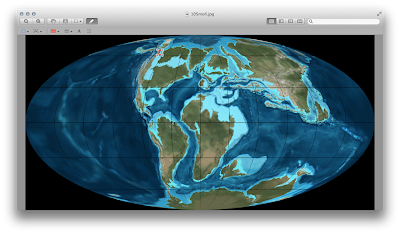Humans have existed for an insignificant amount of time on the planet, and during our time here the continents have remained observably stationary; however, throughout geologic time our continents and the distribution of land masses has actually varied quite greatly. In response to these shifts in land mass, our planet undergoes a number of consequences, probably the most severe of which is climate change. As we have learned throughout class this semester, the position and arrangement of land masses greatly affects the patterns that air masses, ocean currents, and our overall climate undergo. This specific blog will focus on how these shifts change the climate of Valdez, Alaska both 100 million years in the past and future.
Valdez in the Present:
 |
| Present climograph of Valdez |
 |
| Valdez's present location |
Valdez in the Future:
 |
| 100 million years in the future Climograph of the Future |
The climate of Valdez 100 million years in the future would be much different than it was 100 million years in the past. The Aleutian Low would still be the main contributor to Valdez weather, creating storms when it interacts with high pressure to the east, but the storms would be more often and severe than 100 million years in the past because the land mass to the east would be much larger, bringing larger forces of continentality and high pressure. The physical location of Valdez would be much further southwest, probably sitting somewhere around 58 degrees north and 150 degrees west, causing minimal climate variation except for a slight warming in seasonal temperatures as shown by the climograph. The Chugach mountain range would still be a factor, having possibly even grown in size due to the collision of tectonic plates, forcing air masses upward orographically resulting in massive snowfall. One of the largest differences in the future compared to the present is the massive gulf created between Quebec and the Yukon. This gulf would attract low pressure, probably forming something like the Aleutian Low but to the East of Valdez. This semi-permanent system would put Valdez in the middle of two low pressures, which would most likely mean more frequent, violent, and precipitous storms for Valdez as a result. Valdez would still be considered a maritime climate because maritime polar air masses would be affecting the location most of the time, but continental polar and arctic air masses would influence the area more so than 100 million years in the past. Overall, Valdez would see more frequent snowfall and precipitation as a result of its unique position between two low pressure systems and the possible growth of the Chugach mountain range, but the location would remain maritime and temperatures would warm only slightly because of its shift to the south and the resulting increase of incoming solar radiation.











